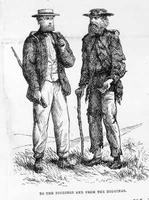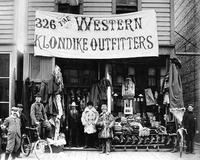Gold Rushes
GOLD RUSHES, a phenomenon of the mid- to late-19th century, were sudden frenetic, short-lived bursts of MINING activity. Several occurred in western N America from California (1848–49) to Alaska (1896–99), and there were others in Australia (1851, 1886), New Zealand (1857) and S Africa (1886). The stampede attracted large numbers of prospectors and an equally large number of "camp followers" who took advantage of the mining activity: merchants, packers, saloonkeepers, gamblers, dancehall girls, prostitutes and others. Gold rush mining was placer mining; that is, it relied on surface deposits that did not require a great deal of equipment, capital or know-how to exploit (see GOLD). Gold rush communities tended to appear almost overnight, flourish for a brief period, then decline as the surface gold played out and prospectors moved on in search of the next strike. In some cases, however, gold camps grew into permanent settlements; many an Interior community in BC owes its origins to one of the rushes.
In BC, gold was first mined at Gold Harbour on the QUEEN CHARLOTTE ISLANDS by the HBC in 1851–52, but the first real rush of gold seekers occurred in 1858 when tens of thousands of prospectors, mainly Americans, arrived in the canyon of the FRASER R (see GOLD RUSH, FRASER R). These newcomers worked their way north up the river and entered the CARIBOO country, where the first major gold find occurred in the summer of 1859. The search extended north and east through the CARIBOO MTS, became centred at BARKERVILLE in 1862, and peaked the following year when an estimated 10 tonnes of gold left the area (see GOLD RUSH, CARIBOO). Subsequent stampedes into the WILD HORSE CREEK (1863–66), Big Bend (1865–66), Omineca (1870–72) and CASSIAR (1870s) areas (see also GOLD RUSH, BIG BEND; GOLD RUSH, OMINECA) were less productive than the Fraser R and Cariboo rushes, but gold remained the most valuable mineral produced in BC until 1884, by which time placer techniques had given way to lode mining. Although the dream that drove a gold rush was to "get rich quick," most prospectors returned home with empty pockets. Still, gold rushes had a profound impact on BC. The Fraser R rush led to the creation of the mainland colony of British Columbia in 1858 and much of the early government and transportation infrastructure was put in place to service and regulate the miners (see CARIBOO WAGON ROAD). Gold brought the first sizable number of non-aboriginal people into BC, including small but significant numbers of CHINESE and BLACKS. The mining camps provided a market for foodstuffs and supplies that expanded opportunities for farmers, ranchers, loggers, bankers and merchants. In other words, gold was the foundation on which a diversified ECONOMY began to develop. The influx of miners also led to clashes with aboriginal people that heralded a new, more antagonistic attitude to BC's indigenous people than had existed during the FUR TRADE period (see FIRST NATIONS; CHILCOTIN WAR).
The world's last great gold rush was to the Klondike in 1896; though these goldfields were located in the Yukon, this rush too had an important impact on BC. Many thousands of "stampeders" passed through the province on their way north, spending money on supplies, hotel rooms and steamer tickets. Businesses profited greatly from this traffic, which pulled BC out of an economic recession and fuelled a growth spurt in which VANCOUVER surpassed VICTORIA as BC's economic metropolis.


